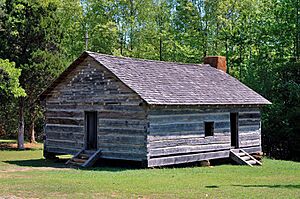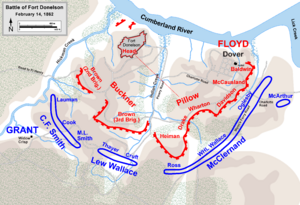C. Carroll Marsh facts for kids
Quick facts for kids
Charles Carroll Marsh
|
|
|---|---|
| Born | September 17, 1829 Oswego, New York |
| Died | unknown |
| Allegiance | United States of America Union |
| Service/ |
United States Army Union Army |
| Years of service | 1861-1863 |
| Rank | |
| Commands held | 20th Illinois Infantry Regiment |
| Battles/wars | American Civil War |
| Other work | lawyer |
Charles Carroll Marsh was an important officer in the Union Army during the American Civil War. He fought bravely in early battles like Fort Donelson and Shiloh. People often called him "C. Carroll Marsh" in official army papers.
Contents
Growing Up and Early Career
Charles Carroll Marsh was born in Oswego, New York, in 1829. When he was 24, in 1853, he moved to Chicago, Illinois. He planned to study law there. However, there were already many lawyers, so he stopped studying law after just one year. Marsh then tried other types of businesses. He also joined a group called the Chicago Light Guard and became a captain.
Serving in the Civil War
Joining the Fight
Because the Chicago Light Guard was well-known, Captain Marsh was asked to come to Springfield, Illinois. This happened right at the start of the Civil War. He quickly offered his help and was given command of the 20th Illinois Volunteer Infantry Regiment. Colonel Marsh and his soldiers went to Cape Girardeau, Missouri. They joined Colonel Joseph B. Plummer's group at the Battle of Fredericktown.
The Battle of Fort Donelson
Colonel Marsh and the 20th Illinois were first stationed at Bird's Point, Missouri. Later, they joined Ulysses S. Grant's trip to Fort Henry. They were part of W. H. L. Wallace's brigade in John A. McClernand's division.
At the Battle of Fort Donelson, Marsh's troops were on the right side of the Union lines. On February 15, the Confederate army tried to break out. McClernand's entire division was hit very hard. Even though his troops were under great pressure, Marsh led a counterattack. This attack stopped Simon B. Buckner's division for a short time. It also saved an Illinois artillery battery from being captured.
Fighting at Shiloh

After the victory at Fort Donelson, General Ulysses S. Grant became very famous. But he also faced criticism from his commander, Henry W. Halleck. During this time, Colonel Marsh and other officers gave Grant an ivory-handled sword. Marsh used this chance to publicly say he trusted General Grant. He spoke out against the "jealousy" caused by Grant's recent success.
Marsh took command of the 2nd Brigade when General W.H.L. Wallace was promoted. On the morning of April 6, 1862, messengers warned Colonel Abraham M. Hare that a battle had started. But Colonel Marsh did not know about the fighting until a cannonball flew through his camp. Early in the battle, Marsh's brigade was forced to retreat in a messy way. However, he and General McClernand managed to gather units of the 1st Division behind Shiloh Church.
Marsh then led a counterattack. This attack managed to capture a Confederate artillery unit, but it cost many lives. Once again, Marsh had to pull back his shrinking group of soldiers. Around 5:00 PM, he made a final stand, supported by parts of three other brigades. On April 7, he led his brigade to take back ground near Shiloh Church. This was the same area where he had fought the day before.
After Shiloh and Leaving the Army
After the Battle of Shiloh, Colonel Marsh was moved to command the 3rd Brigade, 1st Division. This unit was stationed in Jackson, Mississippi. He was made a Brigadier General of U.S. Volunteers on November 29, 1862. However, this promotion was later taken back.
He was then transferred to command the 1st Brigade in John A. Logan's 3rd Division. This was part of the XVII Corps during the first part of Grant's Vicksburg Campaign. Colonel Marsh resigned from the army on April 22, 1863.


